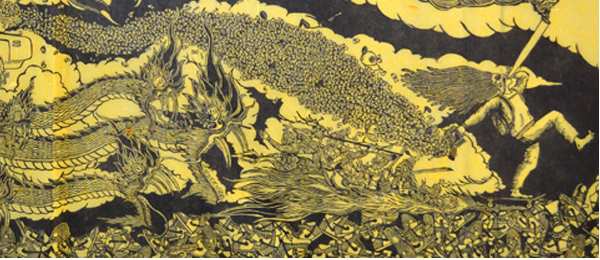Raj’s Jungle: A Linocut That Goes Round and Round
Who would have thought that when I went shopping at Maryland Institute, College of Art’s holiday sale last December I’d end up with an eight-foot linocut. Actually, I originally had four two-foot prints.
After sifting pass tables of textiles and jewelry on the lobby level of the Brown Center, I descended the stairs to the auditorium level where student printmakers had set up a long table stacked with prints, but what caught my eye was a huge relief print clipped high up a makeshift wall behind the student salespersons.
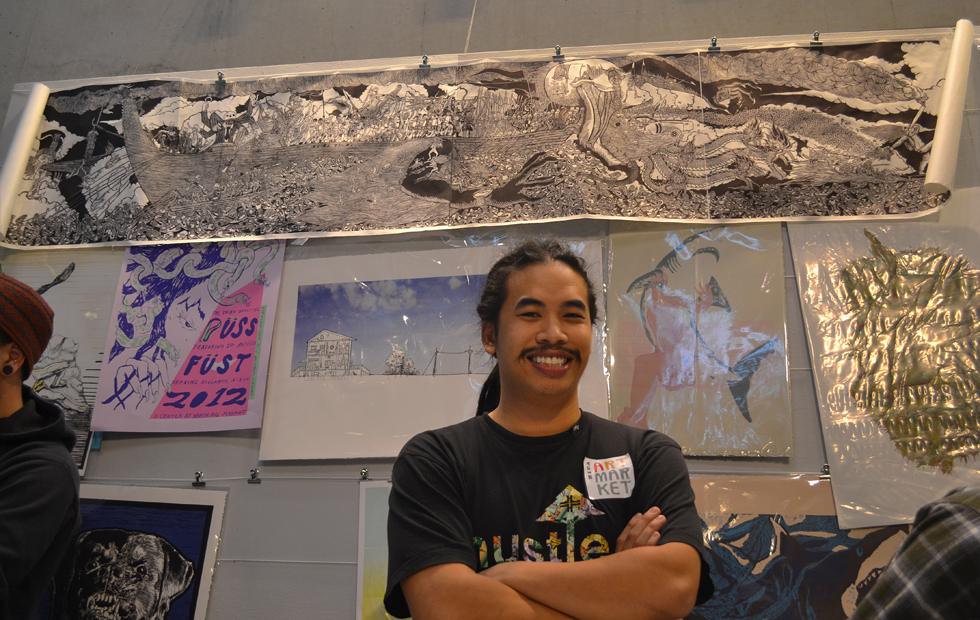
And you guessed it, the young man with the most engaging smile was it’s printmaker: Raj Bunnag, who graduated from MICA the past spring and drove up from his North Carolina home to participate in the sale. He said he cut his print Out Of The Jungle It Came on four pieces of artist linoleum but printed them on one piece of paper to create the print on display. Furthermore, he said, the right-hand end of the image aligns with the left-hand edge of the image to create a continuous loop if one were to glue one end to the other. He even had a device made to “play” his print over and over as well as a video made of the device in motion.
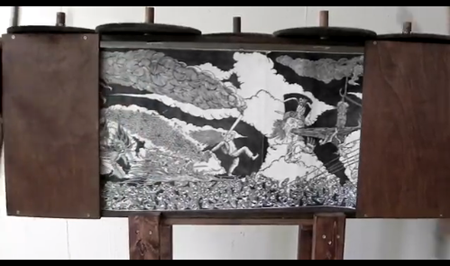
< Here’s a frame from the video that’s available on tumblr: http://rajbunnag.tumblr.com/
The marching figure just right of center is the beginning of the loop (or print), the larger hatted head right of that is the end of the loop (or print).
“What,” I told him, “was I going to do with an eight-foot print? How was I going to display it?” “No problem,” he said, “I also printed the blocks separately.” He then pulled out four prints on white paper in neat glassine envelops. This, I thought, was something I could deal with, at least store safely and one-day frame. I don’t recall the ensuing repartee, but I did know that I didn’t have the funds to pay Raj’s handsome price. So I invited him to come to the house after the day’s sale to show him some of my print collection and, oh yes I said, bring the four-print version of Jungle.
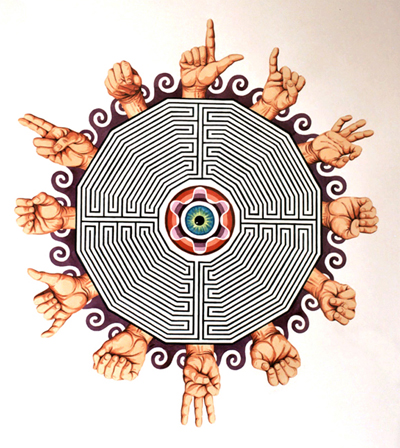
It wasn’t until we were viewing my prints later that day that I offered to trade his prints for one of my watercolors. Considering the motifs behind Jungle, it seemed quite fitting that Raj chose Clock from 2005. In the spirit of Jungle having no end or beginning, Clock has a maze (based on a Roman mosaic in North Africa) with no entrance or exit. “Time, no way out,” reads the sign-language hands surrounding the maze.
After the trade I proposed to post a blog about him and his very ambitious linocut. And within a few days I sent him a set of questions, which he agreed to answer once he returned to North Carolina. A few weeks passed and I didn’t hear from him. In the meantime I started to feel trader’s remorse. “Shouldn’t I have one of his scroll versions of Jungle?” I asked myself. “What about one of the ones he said he printed on a yellow paper?” Just after Christmas I finally called him with a proposal that I ship him the four prints in turn for a yellow scroll. But when I reached him, he was at his parents’ house in Kensington, MD, and he had with him three copies of the yellow scroll (from an edition of five). I drove down and the switch was made. Unlike the version on a single sheet of white paper that I saw at MICA, the yellow version was printed on four sheets of Thai mulberry paper that then were glued together.
The Interview
Raj finally replied to my questions in early January. I’ve illustrated this interview with views of Jungle in a right-to-left sequence.
Give me a brief sense of your upbringing?
I was born and raised in Kensington, MD, to Usa and Aurachun Bunnag. When I was younger, my mom was a dental assistant and my father was a full-time mechanic for Goodyear. We didn’t have a lot growing up so my imagination was the key to my entertainment. My parents’ bedtime stories fueled my creativity as a kid. The Ramayana and other Southeast Asian tales made up the bulk of my nights. Filled with gods and demons and other weird and strange creatures, these stories influence me greatly to this day. When I was old enough to read, the library became a new source for my imagination. Greek, Norse, Hindu/Buddhist, and Medieval myths were a very much a part of me when I started school.
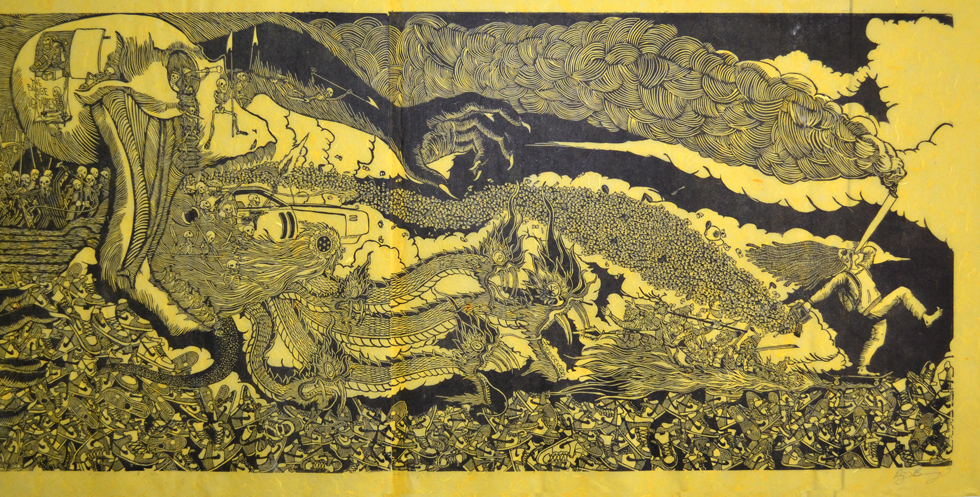
What brought you to MICA?
One key factor in what brought me to MICA was their print lab. The Dolphin Building was everything I was looking for in a print studio–three floors devoted to everything printmaking. It was like having a private printmaking clubhouse that only the printmakers were allowed access to. Out of all the schools I looked into around the Maryland and Virginia area, MICA’s Dolphin Building seemed to stand out the most.
At MICA who influenced you the most?
Trudi Ludwig Johnson would have to be the most influential person to me. She is my print mom. She enlightened me and revealed the iceberg that is printmaking. Prior to meeting her, I had a vague knowledge of the art history side of printmaking. Her class “History of Prints” changed my life. Each week we would be in a different location looking at the actual original prints of the masters. From Dürer to Lichtenstein, we got the whole tour of printmaking from its beginnings to its present state. Examining each piece up close beats a slide show any day. There is something enchanting about seeing how each artist handled his or her print. The masters’ works force you to examine how you create prints yourself. Actually seeing the print and understanding its context help give a true understanding of it.
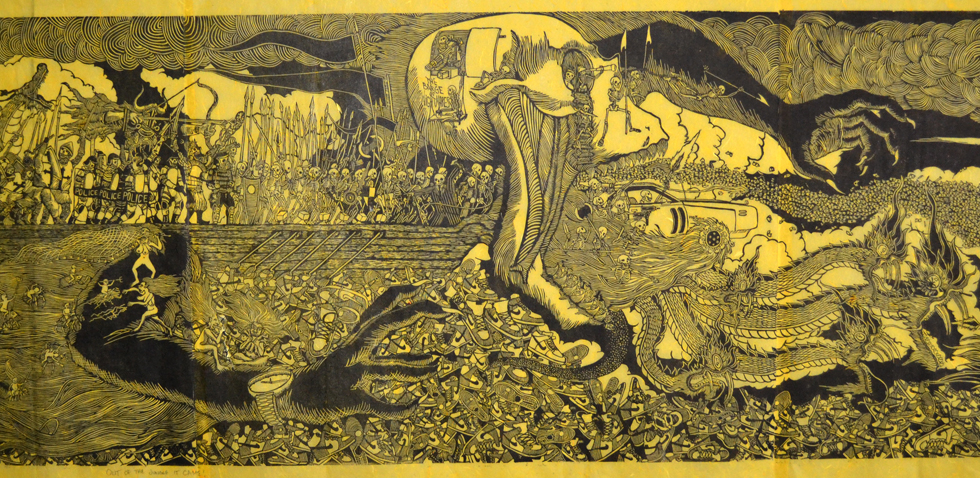
Why do such an enormous project like Out of the Jungle It Came?
When I start projects, I have this tendency to get really carried away with things in the brainstorming period. Originally this piece was supposed to be two blocks, then it became three, and finally stopped at four. I love to draw and carving wood and linoleum has become a very calming meditative practice. I also enjoy the idea of unrolling a giant print scroll and watching the viewer get lost in it.
Which artists inspired you the most?
Posada, Francisco de Goya, Ensor, Rembrandt, Dürer, Piranesi, and Dore are a few of the many that have inspired me. I am also greatly inspired by contemporary printers Artemio Rodriguez, Tom Huck, and Bill Fick.
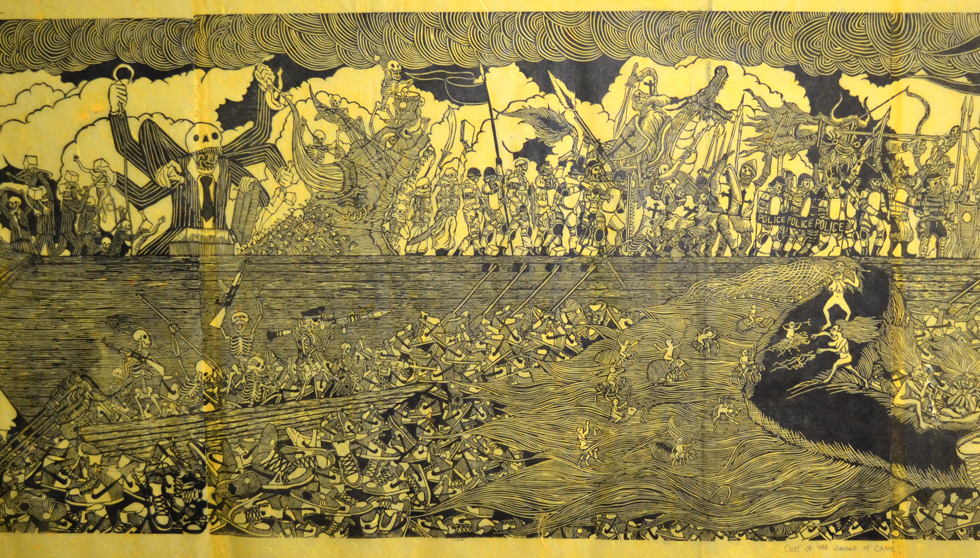
What were the technical hurdles in making Jungle?
I had carved and printed three reliefs prior to this project. Each time I felt I was learning a little bit more about the process. Filling the space and making things flow is a beast all in itself when doing relief work. Out of the Jungle was my first relief print since the end of “History of Prints” with Trudi. After spending a semester examining master prints, I was determined to create something epic.
What was the overriding theme of the piece?
The full title of the piece is Out of the Jungle It Came: The Irrational Fears & Paranoid Delusions of a Sleep Deprived Stoner. The print is one of several pieces that make up the entire project. The ends of the print connect, creating a loop that represents my sleepless nights and irrational fears that are nipping at my heels. The figure to the far right is a dream representation of myself–smoking a novelty-sized spliff, dreadlocks flowing behind me, and not a care in the world, skateboarding over a sea of freshness and sorrow (sorrow referring to my former addiction to shoes made in Nike sweatshops). Behind me is the Barge of Nightmares, the physical manifestation of my irrational fears and paranoid delusions. Filled with pirates, samurai, vikings, mongols, conquistadors, gangbangers, suits, witches, police, knights, jihadists, and demons, this dreadnaught of human atrocity represents the evils of man and strange fears I have pinned to them. The second underlying theme is my ode to the history of printmaking. I incorporated various themes that the greatest printmakers used and regurgitated them into my own contemporary print. My use of skulls and love for them stem from their representation of the mortality of man and is a theme that has been revisited hundreds of thousands of times throughout printmaking. Witches have roots deep in print. They almost always have sagging droopy breasts and the bones of infants dancing along with them. The reason they have three breasts is a pop culture reference to the Arnold movie Total Recall, which I saw when I might have been a little too young. Toward the back end of the ship you find a crew of suits and the mouth of Hell. The suits are taking the “Blockheads,” who represent people abused by the systems of man, and are hooking them and throwing them overboard. As their flesh sloughs from their bones, they are hoisted up into the back end of the mouth of Hell. Within the ship they are given malice, hate, terror, and a weapon and spill back into the world as a minion of darkness. The force that propels this floating terror is the evil breathe of David Lo Pan, the main antagonist from one of my all time favorite movies, Big Trouble in Little China. The movie was always on Sunday afternoons on TV and has come to be a big influence on my art.
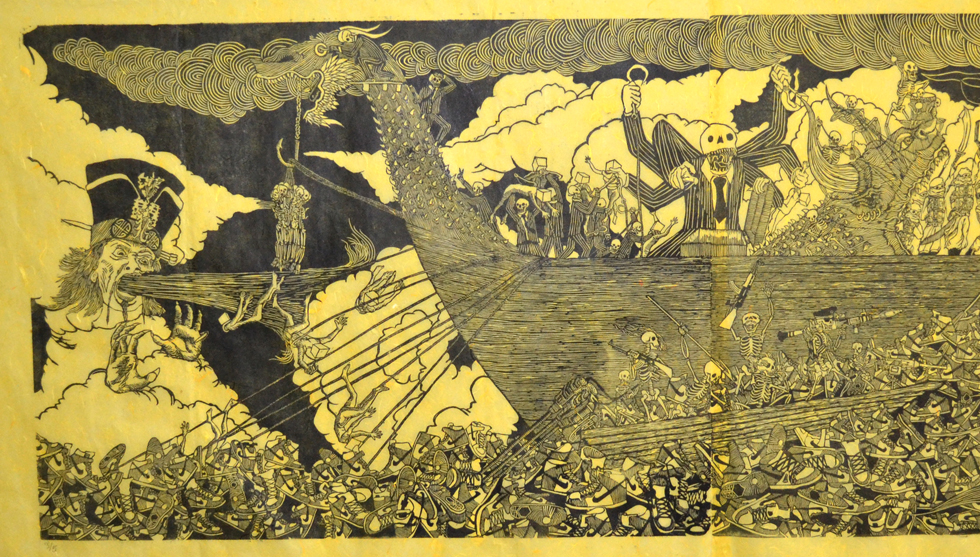
What are you currently working on?
I am currently working on a series of linocuts about the global drug war, using Francisco de Goya’s Disasters of War series as the jump off point. The sad thing is as far as we have come since his time, our missteps and tragedies are still very similar. Capturing the global causes and effects of drugs should keep me busy for a while since it is the modern atrocity effecting us all.
Trackback URL: https://www.scottponemone.com/rajs-jungle-a-linocut-that-goes-round-and-round/trackback/

